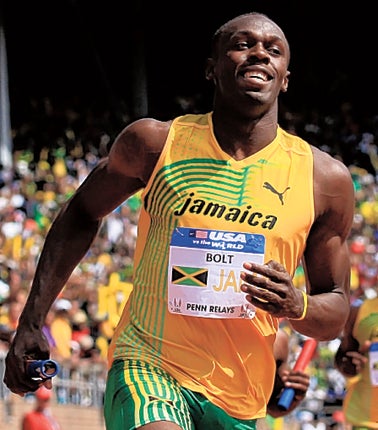Under the Microscope: How fast can a human run?
Answered by: Professor Craig Williams, School of Sport and Health Sciences, University of Exeter

Speed limits
Researchers think 30mph could be the human limit. Most use the 100m to calculate how fast we can run. The current record for the 100m is 9.58 seconds, by Usain Bolt in 2009. That gives a speed of 23.3mph. But interestingly, during the 60-80m stretch of the race Bolt averaged a speed of 27.8mph.
However, as Neils Bohr, the distinguished physicist, said: "Prediction is very difficult, especially if it is about the future". Many commentators previously suggested under 10s was unbreakable; now Bolt's coach is aiming for 9.4s. The 100m record now held by a woman would have beaten the fastest male back in the Fifties.
How to run fast
A key thing is the use of the chemical energy ATP (adenosine triphosphate) in our muscles. This fuels them contract, to move the various joints in our legs, to forcefully hit the ground and turn that energy into speed. For sprinting, having fast-twitch muscle fibres, which quickly translate energy into force, gives you an advantage.
Obviously it's not just about legs. You're driving your arms backwards and forwards. Your trunk area is important – you have to hold your body upright. Coaches will talk about keeping the head steady too.
To improve speed, you train with a combination of sprint drills, technical drills, weight training, rest and recovery. In diet, there's an accent on carbohydrates and protein, which help you to exercise and to recover. Fats are less useful; it's not the kind of energy that can be converted quickly.
Body type for speed
The importance of body shape is a difficult one. Bolt is unusually tall, at 6'5", whereas most sprinters are around 5'11". But we do know athletes are getting taller and heavier: over the last 100 years elite athletes increased in height by 16cm, compared to 5cm in the general population.
Generally, sprinters will have a musculature that is fast-twitch fibre based. Everybody has a percentage of fast and slow twitch muscles, genetically laid down, although some can be promoted by training. There's very little data on fibres of elite athletes because it requires a quite invasive procedure: a needle puncture into a muscle to snip out a bit the size of a rice grain.
External factors
The synthetic tracks that have been developed over the years certainly help athletes move faster. If you're running into a strong wind you're going to be slower, while having wind behind you would help.
Temperature is also important. As you increase the temperature of muscles they are able to generate more speed, so most records are broken on warm, still days. Altitude can help for sprinting, as there's less air resistance.
Manufactures have experimented with clothing. Cathy Freeman, the Australian sprinter, had a body suit with a hood to reduce air resistance, letting the air flow over the body easily. Most running shoes are custom-made and very, very light. There have been advances in design, and these may continue to help people improve.
Chemical and genetic advancements
Anabolic steroids and other drugs do give an advantage. There are medical and health issues, but they could improve performance – that's why they're banned! As far as I know, there's never been anything written where an athlete experiments to see just how fast they could go with steroids, so we don't know exactly what difference they could make.
A lot of people are looking at the area of genetic development to increase speed, particularly muscle development and muscle recovery. But at the moment we don't know enough about the improvements training, technology and nutrition can have, so looking at gene therapy is perhaps getting ahead.
Why don't humans run faster?
Evolutionarily, humans were hunter-gatherers, so it wasn't just a question of speed. Compared to animals, especially with four legs, we are quite slow. We have some speed, although not much if you compare us to a cheetah or even dogs. But then we also have a capacity for endurance, to hunt over days. Now we have more sedentary lifestyles, so sport is what allows members of our society to push these speed limits. In some ways, athletes are representing us as a species in developing our speed.
Send your science questions to
Join our commenting forum
Join thought-provoking conversations, follow other Independent readers and see their replies
2Comments